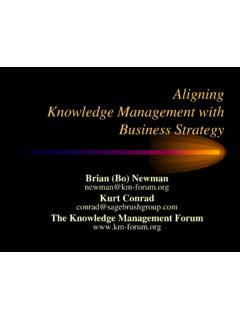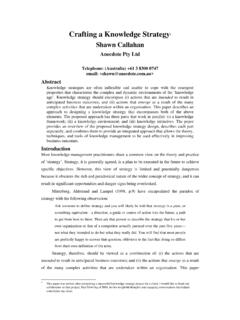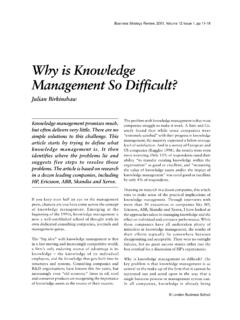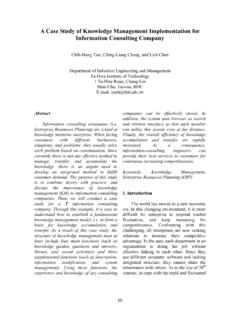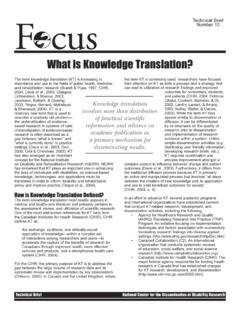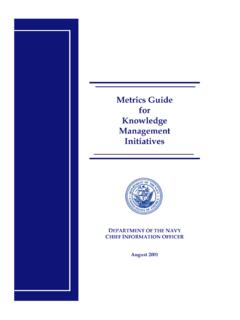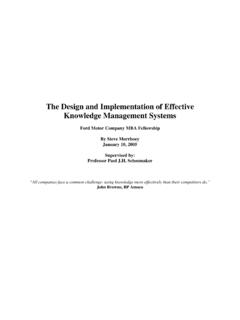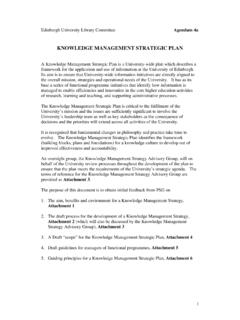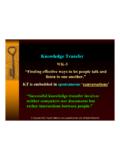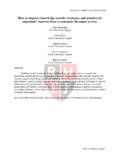Transcription of Knowledge, Intellectual Capital, and Strategy
1 1 knowledge , Intellectual Capital, and StrategyThemes and TensionsChun Wei Choo and Nick BontisThe conversations in this volume about the roleof knowledge in Strategy management may beframed by seven basic questions:1. What unique perspective does a knowledge -based view of the firm offer?2. Should the organization focus on creatingnew knowledge or applying what it alreadyknows ?3. How does an organization create newknowledge?4. What knowledge should the firm share andtransfer, and what knowledge should thefirm protect?5. Is a knowledge -based Strategy the productof careful planning, or the outcome oflearning and discovery?6. What is the difference between managingknowledge and managing Intellectual capi-tal?7. What are the main levers for designing aknowledge-based Strategy ?Most of the chapters in this book directly or in-directly address these questions.
2 We searched forconcepts that would increase our understanding,in two iterations. Below we first review the mainideas presented by contributors in each of theseven parts of the book, highlighting the waysin which they connect with or differ from eachother. After these sectional reviews, we drawupon the principal themes presented by the con-tributors in an attempt to answer the questionsraised above. We conclude this introductorychapter with a framework that brings togetherthe major elements in our discussions aboutstrategic knowledge of the SectionsKnowledge in OrganizationsWe begin part I with two chapters that examinethe fundamental ways that we look at organiza-tions. Adler (chap. 2) revisits the market and thehierarchy as mechanisms for coordination andmakes the observation that a third form of co-ordination based on trust and community will34 CHAPTER 1.
3 knowledge , Intellectual capital , AND Strategy become more important in a knowledge -intensive economy. Moreover, this form of trustis new. Instead of being derived from traditionor loyalty, the new trust is built upon values ofcompetence and integrity. This trust will be tem-pered by hierarchical rules to ensure stability,and by market competition to ensure f l e x i b i l i t (chap. 3) sees the creation and use ofknowledge as the collective outcome of socialpractice that he labels organizational a phenomenon, knowing is situated, medi-ated, provisional, pragmatic, and contested. Apromising framework to analyze knowledgework would be the version of activity theorydeveloped by Yrjo Engestrom, which views hu-man activity systems as multiple mediated in-teractions between individuals, communities orgroups, tools, and concepts.
4 B o i s ot (chap. 4) mapsthe creation and sharing of organization in hisinformation space model. His focus is on the ar-ticulation and diffusion of knowledge . The artic-ulation of organizational knowledge requires ab-straction (creating cognitive categories to makesense of events) and codification (refining thecategories to simplify distinguishing betweenthem). T he more abstract and codified the knowl-edge, the more diffusible it is. Diffusion resultsin use when the new knowledge is absorbed andembedded in practice. Choo (chap. 5) combineselements from Blackler's concept of organiza-tional knowing and Boisot's information-basedanalysis. Strategy is seen as the outcome of or-ganizational sensemaking, knowledge creation,and decision making. The greater the interplaybetween these three information processes, themore effective the organizational learning andadaptation.
5 The final chapter by Despres andChauvel (chap. 6) makes a broad survey of theliterature and identifies seven concepts thatstructure the discussion on knowledge manage-ment: time, type or forms of knowledge , socialspace, context, transformation or dynamics, car-riers or media, and knowledge Perspectivesof the FirmConner and Prahalad (chap. 7) begin part II bycontrasting a resource-based theory of the firmwith the opportunism-based model of the firmin transaction cost economics. T h ey note that theorganizational mode (market or firm) throughwhich individuals cooperate affects the knowl-edge they apply to business activity. Specifically,the organizational mode affects knowledge sub-stitution (how present knowledge is employed)and knowledge flexibility (how future knowl-edge is acquired). I n the choice of organizationalmode, opportunism-independent considerationscan outweigh opportunism-based ones.
6 Whenthe possibility for opportunism is low, transac-tion cost economics predicts the choice of a mar-ket mode. However, the resource-based theorypredicts that a firm organization would never-theless be selected in low-opportunism condi-tions when it results in more valuable knowl-edge being applied to the business (chap. 8) points out that we do have anumber of concepts that articulate a knowledge -based view of the firm: (1) K n o w l e d ge is the mostimportant resource for generating market valueand economic r e n t. (2) Explicit and tacit types ofknowledge vary in their transferability. (3) knowledge is subject to economies of scale andscope, and knowledge -intensive industries mayexperience increasing returns. (4) knowledge iscreated by human beings, who need to special-ize to be efficient in knowledge creation and stor-age.
7 (5) Producing a good or service typicallyrequires the application of many types of knowl-edge. Based on these observations, Grant assertsthat firms exist to create conditions in whichmultiple individuals can integrate their special-ist knowledge . He identifies four integrationmechanisms (rules and directives, sequencing,routines, and group problem solving and deci-sion making) that need to be supported by a baseof "common knowledge " (common language,shared meanings, overlapping knowledge ).Spender (chap. 9) also examines the "integra-tion" theme. He distinguishes two domains ofknowledge management . One presumes thatknowledge is objectifiable as an asset, while theother sees knowledge as the response to uncer-tainty arising from management 's lack of knowl-edge on how to integrate what the firm knowsexplicitly. In the knowledge -based theory of thefirm, knowledge thus has a front face that com-prises knowledge about the elements of the firm'sactivities, and assumes that they are inherentlydesignable; and a back face that analyzes theuncertainties of integrating the front-face ele-ments.
8 As does Grant, Spender considers "com-mon knowledge " the key to this Krogh and Grand (chap. 10) specify thata knowledge -based theory of the firm would needconcepts to explain knowledge origin, knowledgecreation, how the firm establishes coherence, rev-olutionary versus evolutionary changes, and thelink between managerial action and knowledgeCHAPTER 1. knowledge , Intellectual capital , AND Strategy 5creation leading to success. On this last criterion,they suggest that knowledge m a n a g e m e nt shouldfocus on the management of conditions enablingknowledge creation. These enabling conditionsinclude formulating a vision, enabling new expe-riences among members, structuring relation-ships among members, changing the relation-ships, changing the quality of the relationships,and creating knowledge -centered and Bouman (chap.)
9 11) introduce theconcept of information transaction space asthe set of possible information exchanges avail-able to an actor at a point in time: a "marketfor knowledge " where information seekers,providers and brokers organize arrangements forinformation exchange. The object of knowledgemanagement is then the efficient allocation ofthe information transaction space. Four ideal-type governance modes are presented: (1) I n themarket mode, information demand and supplyshape exchange relationships. (2) In the orga-nized market, knowledge management helpssolve the problem of finding reliable sources. (3)In the extended organized market, the focus ison finding sources and asking relevant questionsunambiguously. (4) Finally, in the firm, the in-formation space is organized to address all threeproblems of finding sources, asking relevantquestions, and facilitating i n t e r p r e t a t i on and StrategyIn part III, both Zack (chap.
10 15) and Bierly andDaly (chap. 16) provide definitions of knowledgestrategy. Zack sees it as competitive Strategy thatis built around a firm's Intellectual resources andcapabilities. Bierly and Daly define it as the setof strategic choices addressing knowledge cre-ation in an organization, which guide the devel-opment of Intellectual capital and thus compet-itive advantage. T h e se two chapters also presenttypologies of knowledge strategies that share thesame pair of classificatory dimensions: the de-gree to which the firm creates or applies knowl-edge (exploration vs. exploitation), and the de-gree to which the firm learns or obtainsknowledge internally or externally (internal ). Zack suggests that aggressive knowl-edge strategies based on innovative knowledgethat crosses boundaries would yield superiorperformance.
